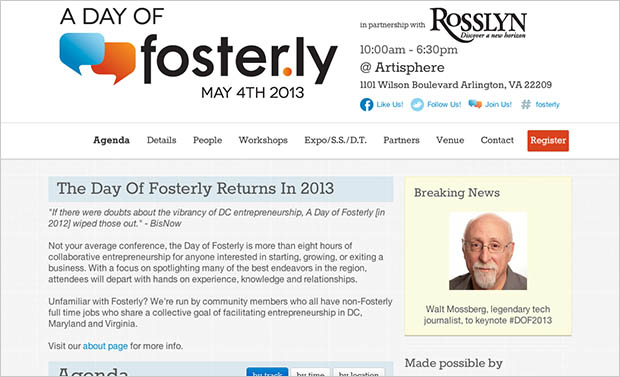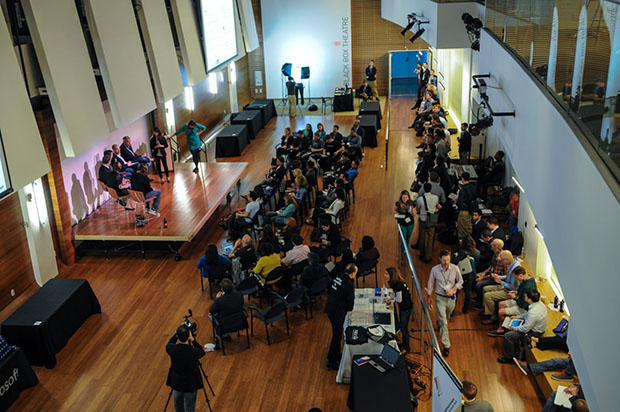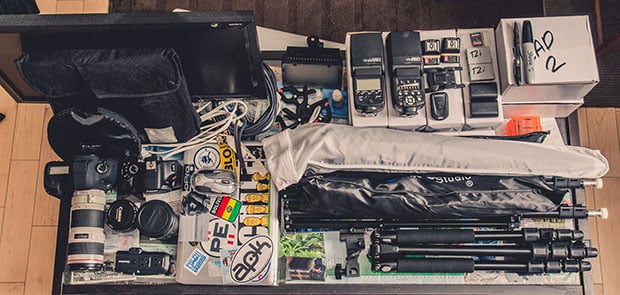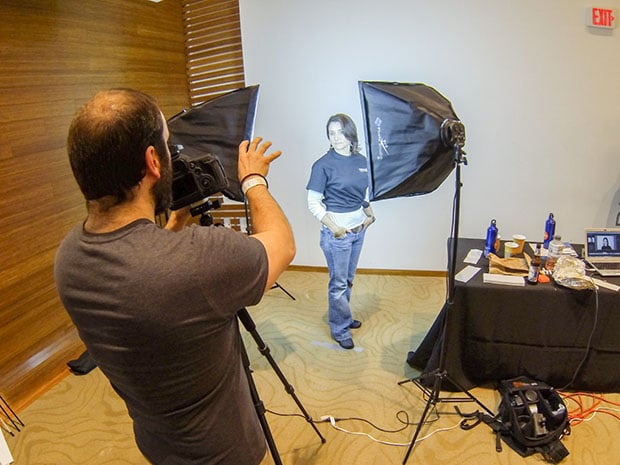What I Learned from Shooting Portraits of 80 People Over 6 Non-Stop Hours
![]()
You know that moment when you agree to do a favor for a friend, and it turns into something a bit… well… more? This past weekend I ended up taking headshots of 80 people during six non-stop hours of shooting. Here is the story of what happened, things I learned from it, and some random thoughts on the experience.
The Story Behind the Shoot
I’m not a professional photographer (I only accept payment to cover costs because I have a full time job and don’t want to ever view photography as “work”), but I do enjoy it and spend quite a bit of time on it. A few months ago, a friend planning a single day DC area startup networking event asked if I’d be willing to spend two hours doing simple headshots of people who wanted updated pictures to use on their Linkedin profiles or bio pages.

I agreed because I’ve never had the opportunity to take photos of other people with a full studio style light setup and knew it would be an immense challenge and incredible opportunity to gain a lot of experience in a (theoretically) very low stress / low expectations scenario. I also like helping people out and seeing them happy about seeing a good picture of themselves, and we all know how much lighting matters there.
Finally, I realize that most people have no understanding of what it’s like to work with a professional photographer or why it’s worth paying someone for good work, and I saw this as an opportunity to plug professional photography services — to give these people a taste and convince them to work with professionals (not me) in the future.
Some professionals don’t agree with this, thinking that an amateur like me taking good pictures of people cheapens the value of their work, but I very much disagree with this philosophy and I’ve seen many people I’ve had some fun with go on to hire expert professionals for future shots as a direct result of seeing the value of having someone other than “a friend with a DSLR” take their pictures.
I discussed this all of this with my friend and we determined I would set up and take headshots for two hours on a first-come first-served basis. We figured 10-15 people would be interested, and I thought with ten minutes per person I would be able to at least get some usable shots. No one had any idea what kind of demand there would be, and nobody remotely expected how the day would play out.
We determined that I would be set up in one side of a large rectangular ballroom area, which included booths and a speaking podium for sessions. I’d have a white wall to shoot against, but would bring a backdrop just in case it wasn’t usable.

Considering I’d be sharing the room with other people and would be trying to make people comfortable on camera and posing consistently as quickly as possible, I decided to shoot with a continuous lighting setup which I had previously only used for video interviews instead of strobes. I also didn’t want to worry too much about batteries, remote triggers, etc. failing when using strobes as my primary light source (I do not own studio strobes, only battery powered ones).
With the basic simple lighting setup decided upon, I made a final checklist of gear to ensure I didn’t leave anything behind:
![]()
This included my main Canon 5D Mark III body, the “cheap” Canon EF 70-200mm f/4 L lens, and a backup T2i with a 50mm f/1.4 just in case. I also packed a backup umbrella and two strobes so I could at least shoot something if the main lights failed.

In order to avoid those frustrating situations where you think a photo is crisp on the camera LCD but find out it’s horrible on the big screen, I brought a laptop and a 24″ monitor so I could shoot tethered into the laptop and review the images quickly as needed.
In testing, I found that Adobe Lightroom was way too slow for me to review the images in anything close to real-time, so I ended up shooting into the Canon EOS capture app for immediate review (2s vs 5s+) while Lightroom auto imported on the back end. All of this turned out to be moot though, as the sheer quantity of people and pressure of the pace meant I did 99% of the reviewing on camera and instead the 24″ screen became a preview for people in line.
On the day, I was up at 7AM. Zipcar loaded and on the move by 8:30AM, on-site and setting up by 9AM. By 9:30AM I was all set up, everything test fired clean, and I decided to use the white background with a single strobe fired remotely onto it to lighten it up. My lighting was dialed in, ambient light was incredibly low which was perfect, the white background reflected just fine, and I was confident the day would be fun and exciting.
I was slated to start at 10AM, but at 9:45AM while joking around with a friend of mine someone came up to me and asked if I was ready to start shooting. I looked up and realized there were already nearly twenty people in line waiting for me… and I hadn’t even started!
The rest is a blur. For each person, I’d give them a card with a URL written on it where they’d be able to get their pictures later and give them a little speech about it. Then I’d have them hold it up like a mugshot so I could track them, after which I’d adjust the lights to get the best look for the individual.
![]()
I’d give them a little speech about posing, then let them do whatever look they wanted while I took a few more shots to check and tweak the lighting. Once I was all set, I typically had them start with a serious look straight on, then joked with them to get some smiles, switch them to a slightly sideways shot, and call it when I was pretty confident I had at least a few good images.
Some people required a LOT of help (especially those with massive forced grins), and I can’t even remember how many times I asked people if they were pushing their tongue against their teeth. The most successful responses I got seemed to be from asking people to “mean mug me” which almost always resulted in nice little half smiles ‘cuz apparently these people weren’t mean.
I had two subjects that knew exactly what they were doing–I spent maybe sixty seconds on them and done, perfect photos–but I had a lot more people who I had to constantly coach and make comfortable and calm them down for a couple minutes before I could get anything.
There was a point a few minutes in where I instantly noticed a huge flare of orange/red light. I looked up and saw that the overhead spotlights for the ballroom had been turned on and knew it was going to completely hose my carefully constructed light. I held shooting for a few minutes while someone tracked down the building event staff and we were able to get half of them turned off, but apparently the other ones were hooked up for the entire room at one go… and obviously, with a couple hundred people in a room doing other things, we can’t leave all the lights off just for the photographer. I’d have to roll with it and see what I could make happen even with some orange spotlights 30-40 feet overhead glaring down on us. And because I’m inexperienced in this kind of situation, I thought “I can fix it in post.”

At noon, after two hours, I finally looked up from non-stop focusing on the person in front of me and was going to call it when I realized there were still nearly thirty people in line… and they had already waited an hour or more. None of us had anticipated the demand, and apparently that little 24″ monitor had been getting people excited all morning as they watched photos pop up on it.
We determined I could keep the space for the rest of the afternoon and I said “okay, let’s do this!” and just kept shooting. Sometimes I’m a glutton for punishment, and even though I knew it was going to hurt I was totally caught up in the rush of the moment and the challenge of working with and shooting all those people.
A friend of mine grabbed me some tacos and I ate one in a quick break around 1PM, a second around 3PM (when I had to move my entire setup over ten feet to the left to make room for a new booth and a nice gentleman insisted I take five minutes to eat after doing so), and the third when I was tearing things down at 4PM. I only stopped at 4PM because we were literally closing down the hall–I still had people in line and was desperately rattling off last minute pictures.
I was partially dismantled with my stuff all over the floor and only the two light stands still up when one final gentleman came running up absolutely begging me to take his picture. I told him half my lights were down, I didn’t have a tripod or review system set up, I’d just shoot him and we’d see what happened. He agreed and ten seconds later I took my favorite picture of the evening:
![]()
Everyone was incredibly grateful. My friend couldn’t thank me enough (yes, many beers are owed), and I was overwhelmed by all the appreciation people showed me for sticking around when I was just caught up and shooting without thinking about the time. I got home and I counted it all up: there were just over 3,000 images of 80 people using up almost 80GB of space.
I started sorting and preparing to edit and laughed as I checked my e-mail to find I already had a couple messages from people saying they’d gone to the URL I gave them and the pictures weren’t there yet! Argh.
I realized that I wouldn’t be able to spend all the time I’d like on the images trying to fix everything in post, so instead settled for basic color correction and trying to remove the worst of the orange cast from the images. I was really happy that almost every person came through with 5-6 usable images that I think will be great on-line profile pictures and some I thought were absolutely fantastic.
At this time I’ve spent around 15 hours and processed the first 60 people, and my favorite images for each of those is included below:
Some Things I Learned From the Experience
#1: When you’re editing free photos of 80 people, you start making compromises. Big time. I simply could not be bothered to smooth out the background of each image, though I did at least mostly clone stamp out the lightboxes. These people have to be content with gray gradients. Masking is just too much trouble. Also: If I had paid more attention to the big screen I would’ve seen that I was getting more falloff and needed to up my background strobe power, but on camera the backgrounds all looked perfectly washed out. Always review the lighting setup on a real screen.
#2: Not having full control of your lighting conditions sucks. The main lights for the ballroom were orange/magenta halogens about 30 feet up that apparently could not be turned off. There was basically nothing I could do but shoot through it and try to drop it out as subtly as possible in post. When I started I figured it wouldn’t be a big deal because I’d only have a few skin tones to fix, but when I went to edit 80 people I just gave up and accepted that no one is going to have a perfect skin tone. Damn orange lights.
#3: Always build in breaks to monitor your setup. I felt so pressured that I kept shooting non-stop. I didn’t check how full my cards were, I wasn’t monitoring my images in detail to see the strobe lighting up my backdrop falling off more and more as the batteries died, etc. This led to some awkward moments with someone standing in front of the lights as I had to switch cards or deal with stuff and stressed me out more than it should have. Worse it meant I was getting larger gradients as the batteries in the strobe got weaker and that kind of thing is very hard to compensate for smoothly in post, and with the orange/red overheads it meant a weird pink cast to the background instead of just gray.
#4: I expected to have time to review images with each person and get their feedback, then maybe put them back in front of the camera to tweak things. Didn’t happen. As a result, I had no need to import images into Lightroom and all that was just extra overhead. People did like seeing their pictures, but it was just a brief check before I went on to the next.
#5: On the other hand, having the images show up on a big monitor facing the line of people seems to have been one of the reasons I had so many interested people. I could at times get a feel for whether or not an image in a sequence was good because there’d be an increase in murmuring/commentary from the crowd who was watching the monitor. Weird feeling.
#6: I did not stop to take a picture of my setup. Or the line. Or, well, anything. This annoys me, I can’t believe I don’t have a shot of it.
#7: Whenever people see my photos, they often assume I’m a professional photographer. When I explain that I’m not, they always seem surprised. “Why not?” they ask. They always laugh when I tell them it’s because I can’t make a living taking pictures of people who think photos should be free. Sometimes, though, I saw the thoughtful look in their eye when I explained how much better the images would be if they got a true professional, worked with them, and paid a fair rate. I hope a few more photographers in the DC area will have some business in the coming months as a result.
#8: At first I was trying different approaches with each person because I got bored with saying the same thing, but I soon realized that giving the same basic speech about posing, the same general encouragement, and cracking the same jokes just flowed and worked the best. The poor ladies in the booth behind me were miming my speeches along with me by the end of the evening. Also, some people were impossible to work with, while a few people were just absolute rock stars. Sometimes it was very difficult to shift gears going from shooting a loose relaxed person to a tight nervous one.
#9: When you get home after spending six hours bent over a camera on a tripod, instead of immediately sitting down and working on your computer to sort the images, it’s probably a good idea to do some stretching or yoga. My back was so tight that evening I could barely move!
Finally, a happy ending: I talked with my buddy and he was not only crazily grateful, but relayed the many thanks of all the people who were there. None of us expected that kind of demand, and now that we know it’s there we can plan ahead if we do this in the future.
His quote was: “next time instead of covering costs, let’s make you some money.” I still don’t like the idea of getting paid to do something for fun, but maybe I’ll put the money towards some studio strobes so I don’t have to worry about batteries.
What an incredible learning experience! Trial by fire. I hope everyone’s happy with the pictures I took.
About the author: Pete Waterman is a photographer, adventurer, technologist, and writer who lives in the Washington D.C. Metro Area. You can find him on his website, LinkedIn, Facebook, and Flickr. This article originally appeared here.